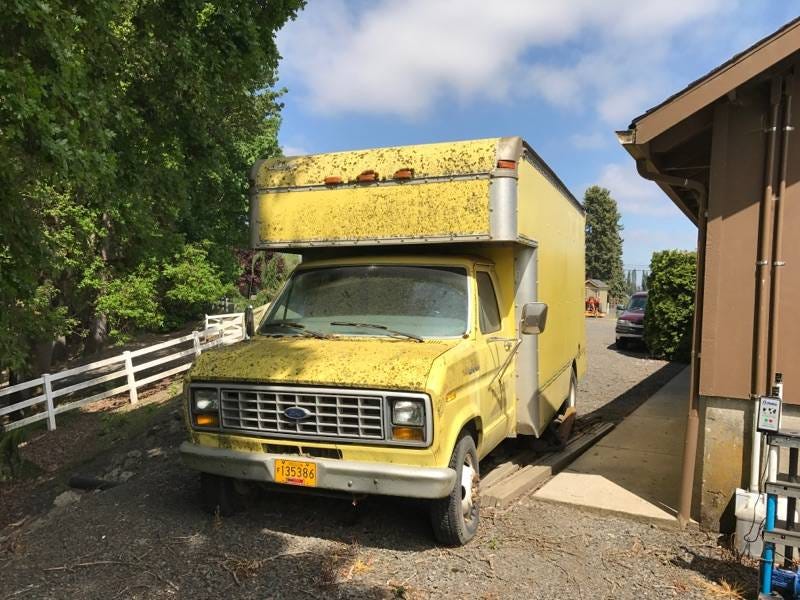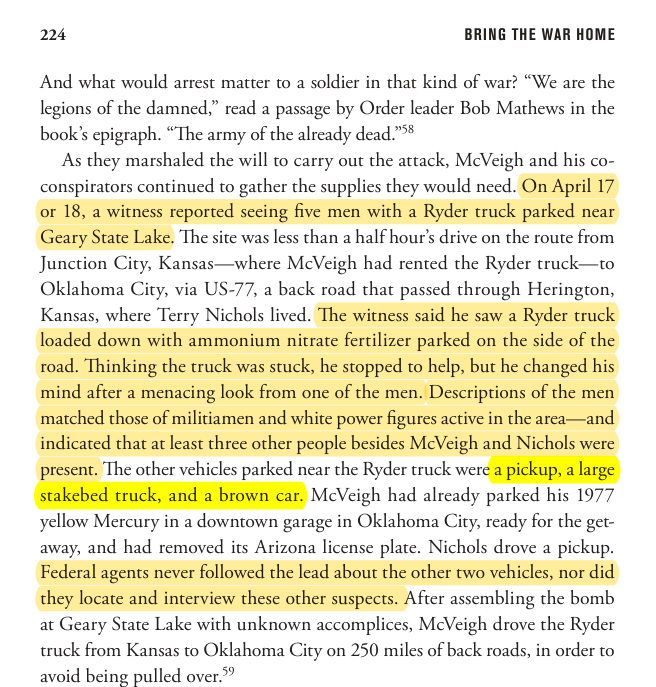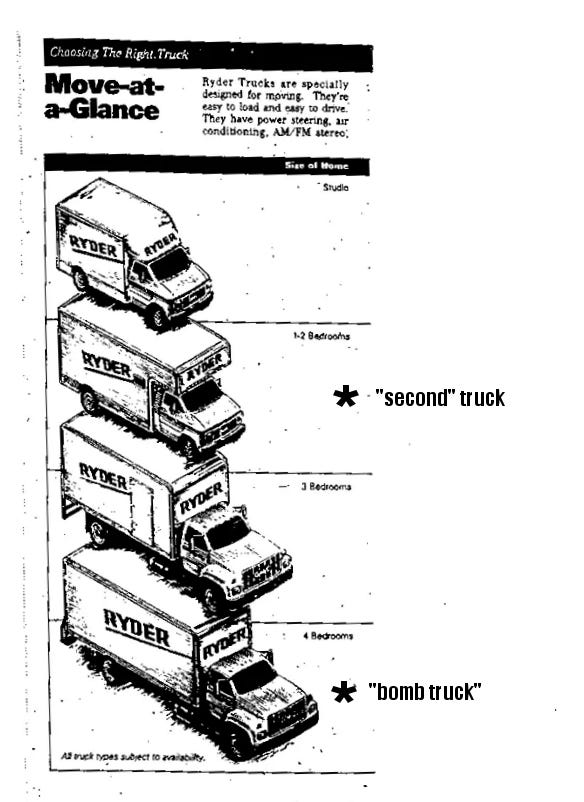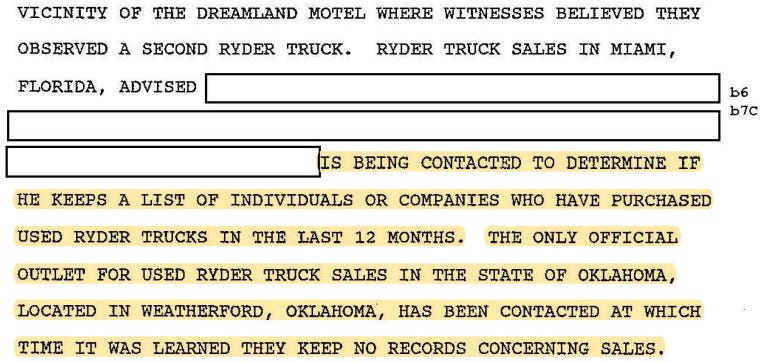McVeigh and the Second Ryder Truck
Witnesses Confirm McVeigh Had Smaller Truck Before Renting Bomb Truck
One of the enduring mysteries of the 1995 Oklahoma City bombing case is the little-known but well-documented and indisputable fact that Timothy McVeigh and the “others unknown” involved in the attack utilized two different Ryder trucks in the late stage of the bombing plot. Whatever became of this second truck, and what it’s purpose was, is still unknown today.
Dozens of witnesses in Kansas observed two very different Ryder trucks between April 11th and April 18th, both at Geary Lake and the Dreamland Motel. One of the trucks was a smaller faded-yellow truck, with no Ryder logo visible on it. The other truck was a larger and newer truck, and was ultimately the truck used to deliver the bomb on April 19th.
Each of these witnesses spotted that second truck with McVeigh at the Dreamland motel (in some cases with a group of still-unidentified men), or alternatively among a group of still-unidentified men at Geary Lake.

The “Bomb Truck”
Records and witness accounts introduced at the McVeigh and Nichols Federal trials establish as fact that the bomb-truck was rented on Monday, April 17th, 1995.
The “bomb truck” was picked up at Elliott’s Body Shop by two suspects, dubbed John Doe #1 and John Doe #2. Each of the Elliott’s Body Shop witnesses described both suspects in great detail, giving the FBI descriptions within days of the rental. The truck was traced to the body shop using a partial VIN# located on an axle of the truck, found buried in the windshield of a car more than a block down the street from the Murrah building.
The “Second Truck”
The evidence introduced at trial also includes clear and convincing witness accounts from the Dreamland Motel and Geary Lake that establish the fact that Timothy McVeigh had to have had a different, smaller Ryder truck, for several days prior to the April 17th rental.
This second Ryder truck has never been explained: not addressed by the FBI, nor mentioned by anyone writing about this case. This second truck, with a few exceptions, is typically omitted from most accounts of the bombing.
A half dozen people at the Dreamland Motel—where McVeigh stayed the week before the bombing—have McVeigh parking the smaller Ryder truck at the motel on Easter Sunday and on Fri/Sat—all days before the bomb-truck was rented at Elliott’s. The witnesses recounted the comings and going at the motel during numerous interviews with the FBI, where they all attested to details that are congruent and serve to corroborate one another’s individual accounts. Taken as a whole, the testimony of these witnesses makes it clear the truck was there.
The Dreamland Witnesses
Consider the following account from Apache helicopter mechanic Shane Boyd. Boyd stayed in room #28 at the Dreamland Motel for several weeks in April of 1995 when he was working at nearby Ft. Riley. Boyd told FBI SA Mark Bouton that at about 6:00 AM Friday, April 14th, he saw a Ryder truck with a steel-framed trailer behind it pulling out of the parking lot of the Dreamland Motel. Boyd also told the FBI that he is certain he saw the Ryder truck parked at the Dreamland Motel again on Saturday the 15th, and on Easter Sunday. At the Nichols trial, Boyd testified that when he returned from work between 3:00 and 3:15 daily he would almost always see the Ryder truck parked at the motel, as he had to walk past the truck each day as he exited his vehicle and went to his motel room.
Consider, too, the accounts of Dreamland residents David King and his mother, Herta King. The Kings both saw the smaller Ryder truck the weekend prior to the bomb truck’s rental. FBI special agents Robert Knox and Leslie Gardner interviewed David King on April 27th regarding activities in and around motel during that weekend and on the following Monday. King told the FBI that on Easter Sunday his mother, Herta King, visited him at the Dreamland around half past noon. King said that both he and his mother saw a yellow Ryder truck parked directly in front of King's room that Sunday afternoon.
Herta King later testified at the McVeigh trial that she saw the Ryder truck parked at the Dreamland on Easter. She testified that she was friends with motel owner, Lea McGown, and they had discussed the truck having been there on Easter Sunday. King said that Lea McGown said "it doesn't make sense that a truck was there on Sunday, if McVeigh rented it on Monday." Indeed, it doesn’t make sense. Consider, then, what does make sense: the truck seen before the 17th was a different truck. This is what the evidence tends to indicate.
Bolstering this theory is that David King has gone on record to say that in fact he saw two different Ryder trucks at the Dreamland. King’s observations are central to understanding the Ryder truck sightings that occurred prior to Monday April 17th. King saw the older "faded yellow" Ryder truck parked at the Dreamland on April 16th, Easter. King then noted a change to the truck from Sunday to Monday: on Monday McVeigh showed up driving a "brand new” and “more aerodynamic" model Ryder truck. This was clearly the bomb-truck that was rented from Elliott’s and its appearance was quite different – much larger – than the truck King and his mother had observed that weekend.
King also saw McVeigh and two other men attaching a trailer to the new Ryder truck and engaged in some sort of activity with the truck and trailer. King recalls this because the Ryder truck blocked access to his parking spot. He said that something was inside the trailer wrapped in a dirty white canvas tarp: “It was a squarish shape, and it came to a point on top, about three or four feet high” King told the New York Times.
Witness Connie Hood would describe a similar scene with the older Ryder truck that weekend: it had a trailer attached to it and a group of guys working there. Hood told McCurtain Gazette reporter J.D. Cash that "I saw John Doe No. 2 with McVeigh in the parking lot, and a couple of other guys were helping them. They were working on that old truck they had. There was a trailer hooked to the truck that afternoon, and it had a lot of stuff in it. I couldn't tell what because a tarp covered the trailer." Witness Shane Boyd also observed a trailer attached to the older model truck that weekend. Whatever it’s purpose, it appears the trailer was moved from the older truck and attached to the new one when McVeigh showed up with it on Monday.
In addition to Shane Boyd, Herta King, David King, and Connie Hood, the proprietors of the Dreamland Motel also noticed the other older model truck. Motel owner Lea McGown and her son Eric described the truck to the FBI and reporters, and had their accounts published in the newspaper.
It was shortly after an Easter lunch when the McGowns saw McVeigh trying to park the Ryder truck. Lea McGown's recollection was vivid, saying, "He backed in jerky, jerky, jerky. Like somebody who doesn't know how to drive a truck. I thought he was going to smash my roof!" Upon watching this, Lea McGown sent her son, Eric, to tell McVeigh to move the truck to the open area in front of the office. Eric McGown got a good look at the truck as he did this, and described it in detail:
"It was medium-sized. It wasn't one of the newest models. It was not so rounded. It had a different compartment for the one cab, and it had the trailer portion." Consistent with other sightings of this second truck, it had a trailer attached and it was older-looking: "its yellow paint was faded and worn, and it had no writing on the back."
The Geary Lake Witnesses
In addition to the Dreamland witnesses, there were also witnesses who spotted a Ryder truck parked at Geary Lake days before the bomb truck was rented.
According to the official narrative, McVeigh built the bomb with Terry Nichols at Geary Lake on April 18th.
Yet, witnesses interviewed by the FBI put a conspicuous yellow Ryder truck at Geary Lake fishing park for four consecutive days the week prior: on the 11th, 12th, 13th, and 14th.
The FBI setup a roadblock at Geary Lake to stop passers-by who traveled that route on the way to work to ask them what they had seen and in doing so obtained testimony from multiple credible witnesses who recalled seeing the truck parked there each morning when they were on their way to work, with some spotting the truck there in the morning, and also on their commute home after work.
Two of these witnesses were Kansas real estate agent Georgia Rucker, and retiree James Sargeant, where the latter spent the week from the 11th to the 14th fishing at the lake each morning. Sargeant testified at trial that “it’s pretty hard to forget something you see four days in a row” – much less something so out-of-place as a gian yellow moving truck parked at a lake.
Perhaps the most curious account from the Geary Lake witnesses is that of Robert Nelson. Nelson testified that he drove into Geary Lake on April 17th OR 18th — he wasn’t sure which day. It was there that he observed the Ryder truck, with several vehicles around it, and a group of 4-5 men.
Nelson testified the McVeigh trial concerning what he had seen, and his account was later cited in Kathleen Belew’s 2018 book Bring The War Home, excerpted below:
When the FBI was interviewing witnesses who saw a Ryder truck—either in Kansas, or downtown OKC—they took to showing the witness a Ryder company flyer which illustrated four different models of Ryder truck. The FBI would ask the witness to identify which type of truck they saw—was it the smaller one with a cab overhang, like the older truck spotted at the Dreamland? Or was it the larger 20 foot truck used to deliver the bomb? Below is the flyer, introduced as an exhibit at the Nichols trial. I have put markers on the exhibit to identify the ‘second truck’ and the ‘bomb truck.’
While Kathleen Belew’s account in ‘Bring The War Home’ says that feds never ‘followed the lead’ of a second vehicle, that isn’t entirely correct. FBI documents from the time include teletypes referencing leads relating to a brown pickup truck, and a full seven months after the FBI had identified the bomb truck as coming from Elliott’s Body Shop, they were still asking witnesses to point out on the flyer which type of truck they saw.
In addition, a November 1995 FBI teletype has FBI agents describing places where a person might purchase a used Ryder truck. They were doing this after the bomb-truck had long been identified, and there is a reason for that—it’s because the FBI knew just as much as anyone reading this will know, that the bombers had a second truck. And the FBI was actively but very quietly investigating where someone might have sourced that older second truck.
Thus, records show that in the middle of the investigation the FBI was actively investigating a bombing scenario which included a second—possibly used or non-rental—Ryder truck.
The Trailer & The Kansas Convoy
The trailer spotted by witnesses at the Dreamland was also spotted attached to a Ryder truck that was driven by Timothy McVeigh and John Doe #2—in a convoy—out of Kansas in the early morning hours of April 19th. Witness Richard Sinnett, a gas station attendant at the Sav-A-Trip in Kingman, Kansas said that McVeigh and John Doe #2 stopped for fuel sometime after 1:00 A.M.
Both suspects entered the convenience store, and Sinnett said that he saw the trailer attached to the Ryder truck in the lot. Sinnett said that the trailer had mounted upon it a large tank with some kind of liquid sloshing around inside of it.
When McVeigh and John Doe #2 left the station, Sinnett said that they pulled out of the parking lot in a convoy of vehicles: the Ryder truck, a pickup truck, and a sedan all traveling in tandem together. This puts the total number of people in the group to four, at a minimum: perhaps some of the others were among the 4-5 men spotted by Nelson at Geary Lake a day or two prior? If so, it corresponds to the descriptions provided by the downtown Oklahoma City witnesses who many said they saw McVeigh with other people the morning of the bombing.
What all of this constitutes is compelling evidence that there is more to the Oklahoma City bombing than we’ve been told: more people involved, and at some point, a second Ryder truck that was smaller than the truck eventually used on April 19th, 1995.
The FBI and prosecutors at trial were unable to fully account for these other suspects observed by the witnesses, nor the other truck. It remains, like many things in the OKC bombing case, unresolved, and yet another piece of the puzzle that it will be up to the independent researchers and investigators to sort out.





